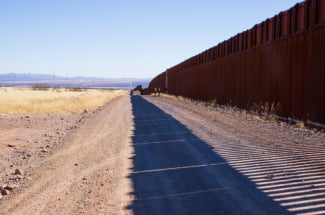
I recently sat for an interview with a reporter who is doing a series of articles on changes in immigration policies with a specific focus on our immigration court system. As I was speaking with this person, our conversation veered outside that lane, and we started talking about changes in immigration policy more broadly. We’ve seen a lot over the past year, but since Donald Trump became our president, the changes in U.S. immigration policy, whether planned or otherwise, have been dramatic. It’s probably not surprising when you have someone like Stephen Miller being the puppeteer for the marionettes.
Some have called it the “invisible wall.” The what? Yes, the invisible wall. While the President has been very public about his desire to construct a physical wall on our Southern border, slowly but surely, he and his minions are quietly and deliberately restricting and slowing the pace of legal immigration by building an “invisible wall.” We’ve seen travel bans, extreme vetting directives, the slowing or stopping of the admission of foreign workers and entrepreneurs into the United States, the ending or reduction of programs for vulnerable populations, and, most recently, obstacles to the naturalization of foreign-born soldiers in the U.S. military.
The most significant change has been processing delays at U.S. Citizenship and Immigration Services (“USCIS”). Most readers of this article are familiar with the H-1B nonimmigrant visa program which, for many employers, requires a petition to be filed on or about April 1 each year for a employment start date of October 1 of the same year. Well, I recently had a case for a client where we filed their petition on April 1, 2018, and their petition was “finally” approved in November, 2019. That’s a year and a half. I will grant you that this is an extreme example, but the point remains. Case processing delays and applications backlogs at USCIS are out of control. These unprecedented processing delays affect individuals, families, and American businesses throughout the nation.
Most of my personal practice involves employment and business-related immigration. I work with employers to facilitate their access to talent in what is now a very tight job market. I work with companies that are on the cutting edge of science; colleges and universities who are educating our future entrepreneurs and investors; and health care professionals in rural areas that supply health care to underserved communities. Processing delays and case unpredictability does not help businesses in my community and beyond solve their very real staffing needs and challenges.
In April, 2019, USCIS responded to a February 2019 letter sent by 86 Members of the House of Representatives who had expressed concern (and demanded accountability) about USCIS’s processing delays. In its response, USCIS revealed that in Fiscal Year (“FY”) 2018, the agency’s “gross backlog”, that is, its overall volume of delayed applications and petitions, reached 5,691,839 cases. That number is staggering, and according to USCIS, marks a 29 percent increase since FY2016 and a 69 percent increase since FY2014. What’s more, this backlog rose from FY2017 to FY2018 despite a substantial decline in application rates and an increase in its budget during that period. That’s right, USCIS had more resources with which to process fewer new cases, yet its gross backlog still grew. I’m sorry, what?
According to a recent article in the Washington Post, there an estimated 800,000 foreign nationals who are working legally in the United States who are also waiting for a green card. Most of those in the queue are Indian nationals. According to the article, an Indian national who applies for a green card today could expect to wait up to 50 years to receive it.
What about citizenship applications? Since 2016, the processing time for citizenship applications has almost doubled, increasing from about 5 ½ months to over 10 months as of March 31, 2019.
Lawyers are now more than ever taking matters into their own hands. While it used to be the case that lawyers waited to sue the government until a client’s application or petition was denied, or perhaps waited until a case was “outside normal processing times” to sue, but processing times are so out of whack immigration attorneys have no choice but to sue.
It’s difficult enough explaining the ins and outs of our immigration system and processes to clients. Tack on the substantial costs involved in pursuing some immigration benefits (without the prospect of litigation to simply move the case along), and top it off with significant delays, and you can see why many in Congress and the media have called the delays we’re experiencing as being at crisis levels. These delays and backlogs have real impacts on individuals, families and businesses. It impacts our overall economic growth. We deserve better.
As we usher out 2019 and bring in a new year (and a new decade), let’s resolve to pass meaningful and comprehensive immigration reform, be a lot more compassionate to those of our southern neighbors who are fleeing their home countries in search of a better and safe life, and work a little harder to poke some holes and even knock down that invisible wall that’s been erected over the past three years.
[1] “Historical National Average Processing Time for All USCIS Offices,” USCIS, March 2019, https://egov.uscis.gov/processing-times/historic-pt.
